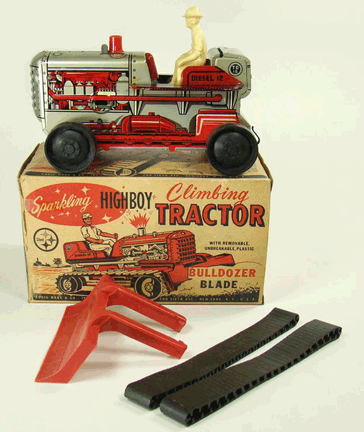 Toy
collectors seem to live by the motto “Mint-in-box.” A toy is only worth
half as much without its original packaging as with it. And the more of
the packaging that’s included, the better. But toys were never meant to
be stored on shelves. They’re meant to be played with. So how can you
collect toys if most of them aren’t in their original boxes, especially
the older tin-plate toys? The answer is very selectively.
Toy
collectors seem to live by the motto “Mint-in-box.” A toy is only worth
half as much without its original packaging as with it. And the more of
the packaging that’s included, the better. But toys were never meant to
be stored on shelves. They’re meant to be played with. So how can you
collect toys if most of them aren’t in their original boxes, especially
the older tin-plate toys? The answer is very selectively.
Children who never damaged their toy soldiers, and carefully kept pieces
and boxes; are reaping the benefit in later life. By carefully playing
with their toys, these children, now grown adults, may have items that
are worth quite a bit of money.
Collections of toys run the gamut from early tin-plate toys to
modern-day action figures and everything in between. But not all fetch
good prices. For instance, a German Bitty Lizzie maid with floor
polisher, made around 1920, has sold for over $500. Made possibly by
Fischer and in working condition, she’s lithographed with a blue
pinafore over a red dress with white polka dots, brown shoes and dark
brown bun hair. She has rosy cheeks and holds a floor polisher with wire
handle, orange-yellow head with yellow felt polisher beneath.
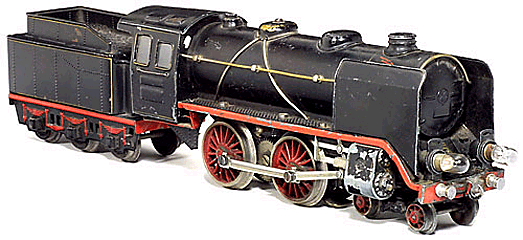
Clockwork train sets were every child's
dream. Marklin or Bing made some of the best, each coming with a
selection of locomotives, cars, and accessories. Today, even a single
passenger car by a top maker in original condition can bring hundreds of
dollars at auction. But the brightly painted tin railway cars of lesser
makers are still within reach.
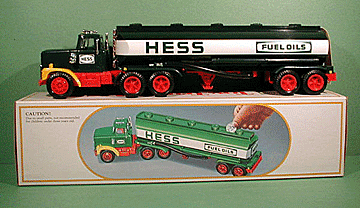 On
the other side of the coin, are toys made in such numbers that their
value is practically zero—less than what they
cost originally. A good example is the Hess Toy Truck. Early on,
collectors learned to buy two trucks, one to give to their child to play
with and another to keep safely sealed in its box for future value.
Unfortunately, Hess Oil Company didn't limit the number of trucks it
sold. In fact, it increased them while the consumers were still eager to
buy them. Today, only the very early Hess Trucks are worth anything. And
all those who began collecting later in the 1990s are literally left
holding the bag.
On
the other side of the coin, are toys made in such numbers that their
value is practically zero—less than what they
cost originally. A good example is the Hess Toy Truck. Early on,
collectors learned to buy two trucks, one to give to their child to play
with and another to keep safely sealed in its box for future value.
Unfortunately, Hess Oil Company didn't limit the number of trucks it
sold. In fact, it increased them while the consumers were still eager to
buy them. Today, only the very early Hess Trucks are worth anything. And
all those who began collecting later in the 1990s are literally left
holding the bag.
Some action figures were likewise over
produced. Once toy makers realized how popular these toys were, they
made more and more of them. Only by controlling production and limited
the number of toys produced can supply and demand work in favor of the
collector.
Antique Toys
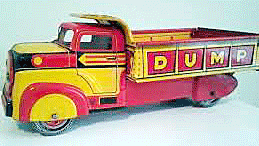 While
all antique toys are not tin-plate toys, the majority of them are. This
group in particular usually appreciates in value 10 to 15 percent each
year. Popular antique tin toys include trains, robots, miniature
soldiers, and tin lithograph toys. There are also many valuable antique
character tin toys on the secondary market.
While
all antique toys are not tin-plate toys, the majority of them are. This
group in particular usually appreciates in value 10 to 15 percent each
year. Popular antique tin toys include trains, robots, miniature
soldiers, and tin lithograph toys. There are also many valuable antique
character tin toys on the secondary market.
Unfortunately, you’ll also find many cheap reproductions of antique
tin-plate toys on the market. Collectors consider toys antique if
they’re at least 100 years old and vintage if they’re made before 1965.
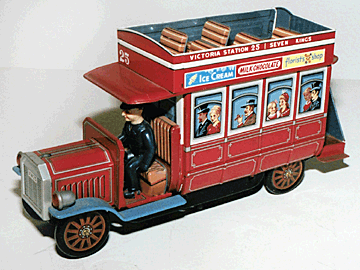 Tin
toys made in Japan during the 1950s and 1960s are most valuable because
they were the most realistic tin toys of their time. After 1965,
children's safety concerns drove the popularity of tin toys down, and
production in Japan came to an immediate halt. When shopping for antique
tin toys, it's important to be on the lookout for counterfeits.
Tin
toys made in Japan during the 1950s and 1960s are most valuable because
they were the most realistic tin toys of their time. After 1965,
children's safety concerns drove the popularity of tin toys down, and
production in Japan came to an immediate halt. When shopping for antique
tin toys, it's important to be on the lookout for counterfeits.
One way of spotting a counterfeit is if Phillips head screws have been
used in its construction. Also vintage tin toys are known among
collectors for their workmanship. Seams match perfectly and there should
still be traces of the original paint.
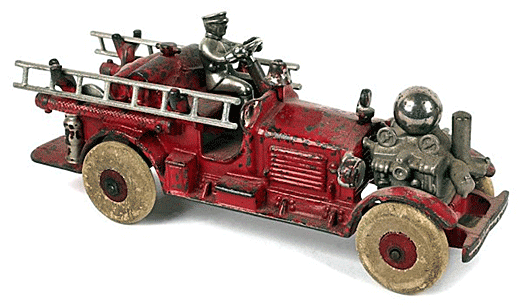
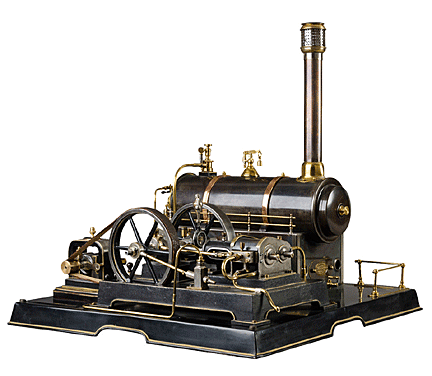 Popular
tin toys from the 1950s and 1960s will not be worth as much as unusual
tin toys produced during the same era. You may be surprised to learn the
tin toys you played with a children aren’t the tin toys selling for
thousands of dollars. The toys worth the most are often never played
with by children. Japanese toys, for instance, are some of the most
valuable tin toys on the secondary market. While some of these toys made
their way to the United States after World War II, there are many that
never reached the states or arrived in very limited.
Popular
tin toys from the 1950s and 1960s will not be worth as much as unusual
tin toys produced during the same era. You may be surprised to learn the
tin toys you played with a children aren’t the tin toys selling for
thousands of dollars. The toys worth the most are often never played
with by children. Japanese toys, for instance, are some of the most
valuable tin toys on the secondary market. While some of these toys made
their way to the United States after World War II, there are many that
never reached the states or arrived in very limited.
And unlike their modern plastic
counterparts, tin-plate toys are subject to rust. Corrotion from rust
has ruined many a tin toy. And once it begins its work, rust is very
hard to eradicate.
When collecting toys, it pays to know as
much as you can about the ones you wish to collect. It also pays not to
buy damaged toys, even if the price is low. Toys in the best condition
will eventually bring the highest prices.
< Back to Collecting Archives
Next
Article >
